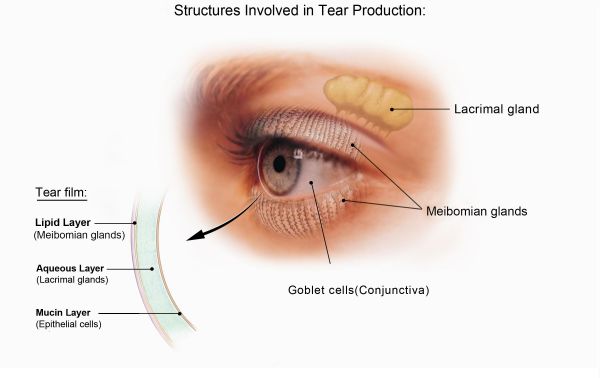Meibomian gland dysfunction (MGD) is when the eyelid glands don’t produce enough oil to stop the watery layer of the tears from drying out. Below we explain what causes MGD and when you should seek treatment.
The normal tears of the eye are made up of three layers – an oily (lipid) layer, a watery (aqueous) layer, and a sticky (mucous) layer. MGD is when the glands that make the oily layer of the tears are not working properly, allowing the watery layer of the tears to dry out too quickly.
The meibomian glands are inside the eyelids, and the openings are on the edge of the eyelids. When the glands become blocked, the oily part of the tears cannot be released, causing the watery tears to dry up more quickly, resulting in the eye becoming dry and making it feel uncomfortable or sore. It is not usually a serious condition but can cause discomfort and sometimes blurry vision. If left untreated, the glands may stop working permanently. MGD can also cause dry eye. It is common to have a combination of MGD, dry eye and blepharitis.

MGD is a common condition and can affect anyone. However, it is more likely to happen after the age of 50, if you have diabetes or oily skin conditions. It is also more common in women.
The eyelids can become sore and swollen as the glands become blocked. As the eyes become dry, they can feel itchy or gritty, as if there’s something in the eye. The eyes may be red, and if they are sore, may become watery, which can cause vision to become blurry.
Treatment involves releasing the oily tears from the glands using hot compresses. You need a hot compress either a special microwavable eye bag or a warm flannel soaked in hot (not boiling) water. Close your eyes, and hold the hot cloth onto your eyelids. If using a flannel this will need repeatedly soaking with hot water. The microwavable eye bags make it easier to direct the heat and are much more effective than a hot cloth as they will hold the heat. Keep applying the compress for at least five minutes. Repeat every day until the condition gets better.
Your Optometrist can give you further advice on this. To help prevent the glands from blocking up again continue the treatment every day for a few minutes.
Treatment method